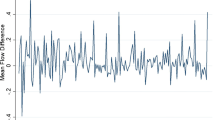Abstract
The primary focus of this paper is to investigate whether the introduction of investor risk classes to the fund performance model affects relative performance rankings. In other words, are investor risk classes relevant? This analysis is conducted in an Extended Mean Gini (EMG) CAPM f ramework. Our results support the conclusion that investor risk class is not relevant to the performance ranking of a fund. Thus, it would seem that fund managers are not developing portfolios which are suited to a particular class of risk averse investors. Furthermore, based on our results, equity fund managers are unable to outperform the market portfolio. Finally, we find no relationship between performance and perceived level of activity — thus suggesting the irrelevance of perceived management style.
Similar content being viewed by others
References
Benson, K. and Pope, P. (1993), Active or passive — what’s the difference? Journal of the Securities Institute of Australia, 4, 25–34.
Bird, R., Chin, H., and McCrae, M. (1983), The Performance of Australian Superannuation Funds, Australian Journal of Management, 8(1), 49–69.
Hallahan, T. (1999), The Information Content of Portfolio Performance History and Persistence in Fund Performance: An examination of rollover funds, Accounting and Finance, 39(3), 255–274.
Hallahan, T. and Faff, R. (1999), An Examination of Australian Equity Trusts for Selectivity and Market Timing Performance, Journal of Multinational Financial Management, 9, 387–402.
Holmes, K. and Faff, R. (2000), Cross-sectional Determinants of Managed Fund Risk and Performance: Evidence for Australian Equity Trusts, Accounting, Accountability and Performance, 6(1), 55–75.
Jensen, M. C. (1968), The Performance of Mutual Funds in the Period 1945–1964, Journal of Finance, 23, 389–419.
Lerman, R. I., and Yitzhaki, S. (1984), A Note on the Calculation and Interpretation of the Gini Index, Economics Letters, 15, 363–368.
Okunev, J. (1989), Mean Gini Capital Asset Pricing Model: Some Empirical Evidence. Accounting and Finance, 29(1), 63–72.
Okunev, J. (1990), An Altemative Measure of Mutual Fund Performance. Journal of Business Finance and Accounting, 17(2), 247–264.
Pratt, J. (1964), Risk Aversion in the Small and the Large, Econometrica, 32, 122–136.
Reynolds, H. T. (1977), Analysis of Nominal Data. Sage University Paper series on Quantitative Applications in the Social Sciences, Series No. 07-007, Beverly Hills: Sage Publications.
Robson, G. N. (1986), The Investment Performance of Unit Trusts and Mutual Funds in Australia for the Period 1969 to 1978, Accounting and Finance, 26(2), 55–79.
Roll, R. (1978), Ambiguity When Performance is Measured by the Securities Market Line. The Journal of Finance, 33(4), 1051–1067.
Sawicki, J. (2000), Investors’ Response to the Performance of Professional Fund Managers: Evidence from the Australian wholesale funds market. Australian Journal of Management, 25, 47–66.
Sawicki, J. and Ong, F. (2000), Evaluating Fund Performance using Conditional Measures: Australian Evidence. Pacific-Basin Finance Journal, 8, 505–528.
Shalit, H. and Yitzhaki, S. (1984), Mean-Gini, Portfolio Theory, and the Pricing of Risky Assets. Journal of Finance, 39(5), 1449–1468.
Sharpe, W. F. (1966), Mutual Fund Performance. Journal of Business, 39, 119–138.
Sinclair, N. A. (1990), Market Timing Ability of Pooled Superannuation Funds, January 1981 to December 1987. Accounting and Finance, 30(1), 51–65.
Treynor, J. L. (1965), How to Rate Management of Investment Funds, Harvard Business Review, January–February, 63–75.
Author information
Authors and Affiliations
Additional information
Deceased, formerly of the Department of Accounting and Finance, Monash University.
Rights and permissions
About this article
Cite this article
Benson, K., Pope, P. & Faff, R. The Relevance of Investor Risk Classes in Ranking Fund Performance: An Application of the Extended Mean-Gini CAPM. J. Quant. Econ. 1, 20–35 (2003). https://doi.org/10.1007/BF03404646
Published:
Issue Date:
DOI: https://doi.org/10.1007/BF03404646




